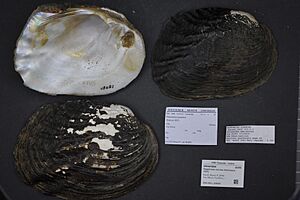Megalonaias nervosa facts for kids
Quick facts for kids Megalonaias nervosa |
|
|---|---|
 |
|
| Museum specimen | |
| Scientific classification | |
| Genus: |
Megalonaias
|
| Species: |
nervosa
|
The Megalonaias nervosa is a type of freshwater mussel. It belongs to the Unionidae family. Most people know this mussel by its common name: the Washboard Mussel.
Contents
All About the Washboard Mussel
The Washboard Mussel has a thick shell made of two parts, called valves. These valves are connected by a hinge. The shell is usually shaped like a rectangle. It can be flat or a bit puffy. The top part of the shell, called the umbo, does not stick up above the hinge.
Inside the shell, there are strong, bumpy "teeth" called cardinal teeth. There are also long, curved "teeth" called lateral teeth. These help the mussel keep its shell closed tightly. The outside of the shell is dark brown to black. It has small bumps and wavy ridges, which make it look a bit like an old-fashioned washboard. The inside of the shell, called the nacre, is white or gray.
Washboard Mussels are filter feeders. This means they pull water into their bodies and filter out tiny bits of food. They release waste through a special tube called an excurrent siphon. These mussels do not move around much. They usually stay anchored in the riverbed or buried in the mud, sand, or gravel.
Life Cycle and Reproduction
Washboard Mussels usually become old enough to reproduce around 8 years of age. Males are ready to reproduce from July to October. Females carry eggs from August through October. The eggs are fertilized inside the female mussel.
These mussels have a special larva stage called glochidia. When it's time to release them, the mussel uses a lure to attract fish. When a fish gets close, the mussel releases the glochidia. These tiny larvae then attach to the gills or fins of the fish. They stay there and feed on the fish's blood until they grow into young mussels.
Some fish that host Washboard Mussel glochidia include the longnose gar, largemouth bass, yellow perch, longear sunfish, bluegill, slender-head darter, and log perch. Once the glochidia are released, the parent mussel does not provide any more care. Studies show that water temperature is important for reproduction. If the water is too cold, the mussels may not reproduce.
Where Do Washboard Mussels Live?
You can find Washboard Mussels in small or large rivers. They live in different types of riverbeds, including mud, sand, or gravel.
Even though the Washboard Mussel is not currently in danger of disappearing, many mussels have faced problems. Their homes can be harmed by pollution, new species that invade their habitat, and dams that block rivers. Also, in some places, the number of Washboard Mussels reproducing has gone down because the water temperature is too low.
Where Can You Find Them?
Washboard Mussels live in the Mississippi River system. They are also found in rivers that flow into the Gulf of Mexico, from the Ochlockonee River system all the way west to the Rio Grande. Their range also extends into northeastern Mexico. You will not find Washboard Mussels in Canada.
Similar Mussels
The Washboard Mussel looks similar to other mussels. These include the Threeridge mussel (Amblema plicata) and the Rock pocketbook mussel (Arcidens confragosus).

